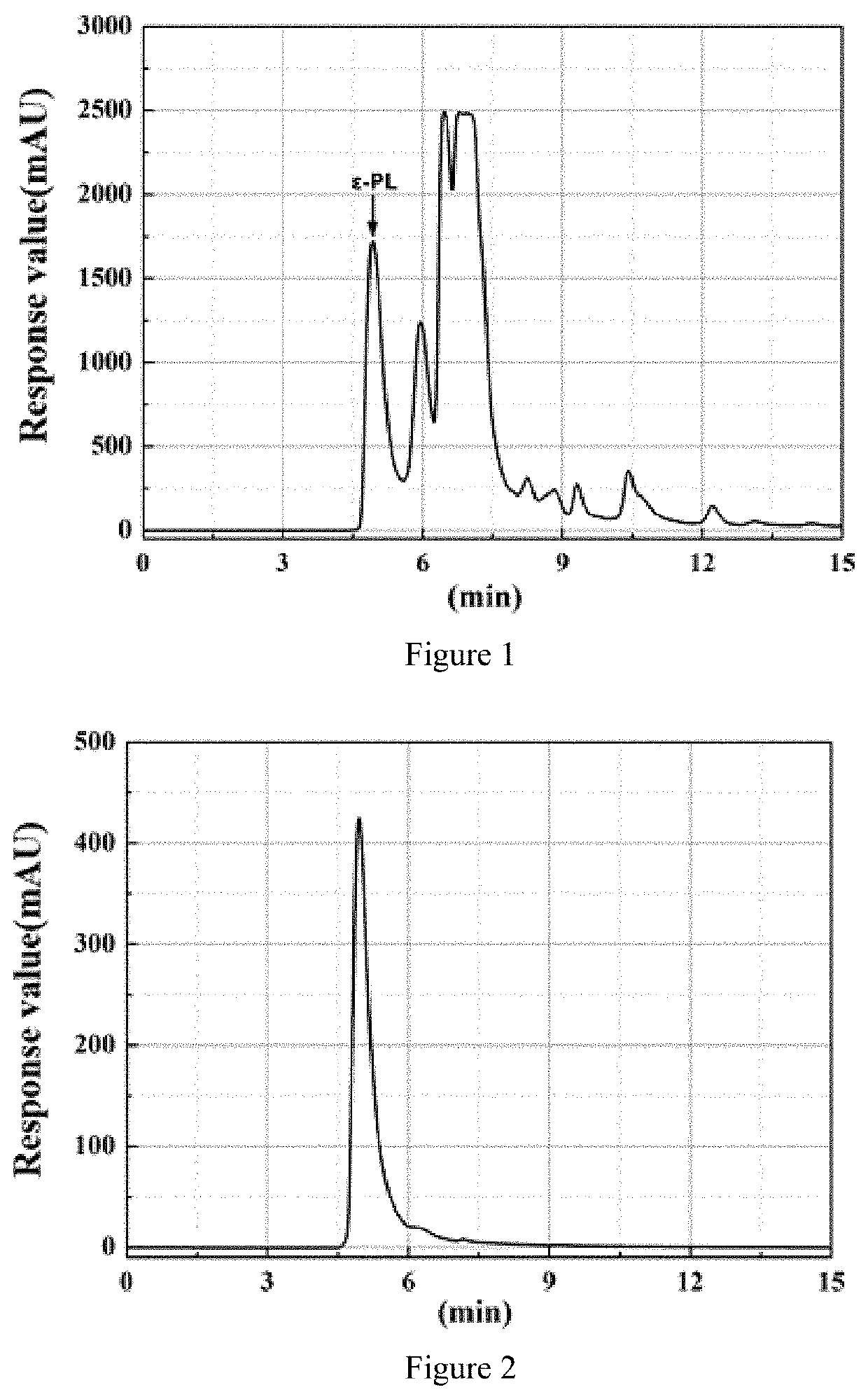Method for extracting epsilon-polylysine and its hydrochloride salt from fermentation broth
a technology of epsilon-polylysine and hydrochloride salt, which is applied in the direction of amphoteric ion exchangers, centrifugal force sediment separation, peptides, etc., can solve the problems of only applicable separation and extraction methods of -pl, and achieve the effect of improving the clearness of eluents, reducing resin contamination, and prolonging the operational life of resin
- Summary
- Abstract
- Description
- Claims
- Application Information
AI Technical Summary
Benefits of technology
Problems solved by technology
Method used
Image
Examples
example 1
on of ε-PL Fermentation Broth
[0044]Streptomyces albulus CGMCC NO. 10480 was inoculated into the 5 L fermentation tank with 6% inoculum volume of fermentation medium, the medium pH was adjusted to 7.5 with ammonia or NaOH. the fermentation process was controlled with the stirring speed 200-800 rpm, temperature 30° C., ventilation 0.5-2 vvm, dissolved oxygen 30%. When pH drops spontaneously to around 5.0 at the first time, the fermentation pH was maintained at around 5.0 for 10 h; then the pH was regulated to 3.0 and maintained for 24 h, finally the pH was adjusted to around 4.5 and maintained until the end of fermentation. When glycerol or glucose concentration in the fermentation broth drops to less than 10 g·L−1, sterilized pure glycerol or 500 g·L−1 glucose solution was fed to maintain the concentration of glycerol or glucose at 10 g·L1; when NH4+-N concentration in the fermentation broth dropped to 1 g·L−1, the concentration was maintained at 1 g·L−1 by feeding the ammonium sulfa...
example 2
on of ε-PL Fermentation Broth
[0046]Streptomyces albulus CGMCC NO. 10480 was inoculated into the 5 L fermentation tank with 7% inoculum volume of fermentation medium, the medium pH was adjusted to 7.0 with ammonia or NaOH. The fermentation process was controlled with the stirring speed 200-800 rpm, temperature 32° C., ventilation 0.5 vvm, dissolved oxygen 28%. When pH drops spontaneously to around 4.8 at the first time, the fermentation pH was maintained at around 4.8 for 12 h; then the pH was regulated to 3.2 and maintained for 26 h, finally the pH was adjusted to around 4.8 and maintained until the end of fermentation. When glycerol or glucose concentration in the fermentation broth drops to less than 10 g·L−1, glycerol or glucose solution was fed to maintain the concentration of glycerol or glucose at 9.5 g·L−1; when NH4+-N concentration in the fermentation broth dropped to 1.0 g·L1, the concentration was maintained at 1.2 g·L1 by feeding the ammonium sulfate solution.
[0047]In acc...
example 3
on of ε-PL Fermentation Broth
[0048]Streptomyces albulus CGMCC NO. 10480 was inoculated into the 5 L fermentation tank with 8% inoculum volume of fermentation medium, the medium pH was adjusted to 6.5 with ammonia or NaOH. The fermentation process was controlled with the stirring speed 200-800 rpm, temperature 30° C., ventilation 2 vvm, dissolved oxygen 32%. When pH drops spontaneously to around 4.5 at the first time, the fermentation pH was maintained at around 4.5 for 15 h; then the pH was regulated to 2.8 and maintained for 22 h, finally the pH was adjusted to around 4.2 and maintained until the end of fermentation. When glycerol or glucose concentration in the fermentation broth drops to less than 10 g·L−1, glycerol or glucose solution was fed to maintain the concentration of glycerol or glucose at 10.5 g·L−1; when NH4+-N concentration in the fermentation broth dropped to 1.0 g·L−1, the concentration was maintained at 0.8 g·L−1 by feeding the ammonium sulfate solution.
[0049]In ac...
PUM
| Property | Measurement | Unit |
|---|---|---|
| temperature | aaaaa | aaaaa |
| concentration | aaaaa | aaaaa |
| molecular weight | aaaaa | aaaaa |
Abstract
Description
Claims
Application Information
 Login to View More
Login to View More - R&D
- Intellectual Property
- Life Sciences
- Materials
- Tech Scout
- Unparalleled Data Quality
- Higher Quality Content
- 60% Fewer Hallucinations
Browse by: Latest US Patents, China's latest patents, Technical Efficacy Thesaurus, Application Domain, Technology Topic, Popular Technical Reports.
© 2025 PatSnap. All rights reserved.Legal|Privacy policy|Modern Slavery Act Transparency Statement|Sitemap|About US| Contact US: help@patsnap.com


